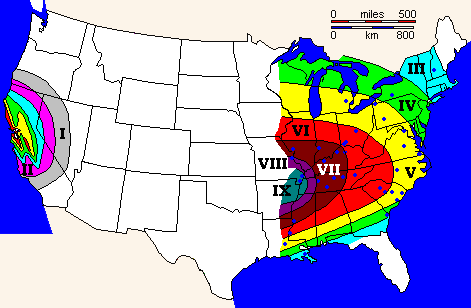
New Madrid Overdue for Large Earthquake
Chris Pagano - Southeast Missourian - Cape Girardeau, MO
Experts offer advice on earthquake preparedness
February 24, 2008
Following the community's major ice storm, representatives from relief agencies presented a program filled with critical information about preparedness for disasters and earthquakes Saturday at the Conservation Campus Nature Center.
A simulated earthquake had been planned, but Steve Besemer, SEMA's earthquake program manager, said the U.S. Geological Survey representatives and other partners presenting earthquake preparedness information were unable to make it due to inclement weather.

 Image: This map compares the 1906 San Francisco earthquake and the 1811-1812 New Madrid shakers. Even with very similarly sized events such as these, New Madrid region quakes will cause wider damage over larger areas because of the geology's flat layers and lack of complexity. There is little here to stop seismic waves so they can travel much further and cause wider damage. Intensity reports from places shown as blue dots.
Image: This map compares the 1906 San Francisco earthquake and the 1811-1812 New Madrid shakers. Even with very similarly sized events such as these, New Madrid region quakes will cause wider damage over larger areas because of the geology's flat layers and lack of complexity. There is little here to stop seismic waves so they can travel much further and cause wider damage. Intensity reports from places shown as blue dots.
Representatives from SEMA, the American Red Cross, Missouri Department of Natural Resources division of geology and land survey and the Central United States Earthquake Consortium had exhibits lining the walls of a classroom packed with informational handouts, including a 1997 Cape Girardeau/Perryville-area earthquake hazards map marked with epicenters of earthquakes magnitude 2.0 and greater.
The consortium offered the following tips for people who find themselves experiencing an earthquake:
* The ground will feel like the deck of a ship. Keep calm.
* When indoors, stay there and avoid shelves, mirrors, heavy objects and windows.
* Take cover kneeling against an inside wall, in a doorway or under heavy furniture. Those in high-rise buildings should not use the elevator and should follow the aforementioned indoor suggestions; in a theater or stadium, stay seated and cover your head.
* If caught outdoors during an earthquake, move to an open area away from trees, buildings, signs, utility poles and wires, and stay there until the shaking stops. Crouch or lie down, as legs will feel unsteady.
* If driving during an earthquake, pull to the edge of the road as quickly and safely as possible. Avoid bridges, underpasses, power lines, buildings and trees. In a car or bus, stay put till the shaking is over.
Natalie Poston and Joe Don Randol, both of Cape Girardeau, believe earthquake awareness is crucial.
"This is something everyone needs to be aware of. An earthquake could be a lot more devastating than the power outage from the ice," Randol said. "We've become overly complacent."
 GRAPHIC
GRAPHIC

Poston said she had experienced an earthquake in her living room but could not remember how old she was.
"Dad told us to go under the table and cover our heads. Nothing fell off the shelves, but there was a vibration," she said.
Randol is prepared with supplies, but, he said, "Unfortunately in this area there's no way to be totally prepared. But you could be prepared enough to survive it."
Just as local and state governments must make plans to be self sufficient in a disaster, so should the public. The Missouri Department of Health and Senior Services developed "Ready in 3," which includes creating a plan for families and businesses; preparing a kit for home, car and work; and listening for information about what to do and where to go during an actual emergency.
Hylan Beydler, division information officer for the DNR division of geology and land survey, said it is the first year earthquake awareness has been recognized for the whole month; before, it was a week long.
Gov. Blunt recently proclaimed February as a time that Missourians should prepare for a major earthquake along the New Madrid Seismic Zone. The zone stretches roughly from the southern tip of Illinois, through the Missouri Bootheel and into northeastern Ark. The most recent earthquake in this area was a magnitude 4.8 in September 1990.
According to the consortium, the probability of an earthquake with magnitude of 6.0 or greater in the central U.S. is fairly significant in the near future, with a 25 percent to 40 percent chance of occurring in any 50-year time period. Scientists believe the area could be overdue for a large earthquake and, through research and public awareness, may be able to prevent losses.
Beydler said that preparing for a quake was important in surviving it. "Disasters like tornadoes come and then they're over. An earthquake, with its potential devastation to gas, water, sewage and power lines, can wear on your psyche." Significant damage takes time to fix, and shock from the trauma may interfere with creating a plan. Gathering up necessities may be more difficult in rubble and places that are risky to enter.
Simple kits stored in a convenient place known to all family members should include eating utensils; a gallon of water per person per day; food; emergency preparedness manual; battery-operated radio, flashlight and extra batteries; cash and change; non-electric can opener; utility knife; toilet paper, soap, feminine supplies and personal hygiene items; sturdy shoes; rain gear; blankets or sleeping bags; special items for infants, elderly or disabled people; and prescription and nonprescription drugs.
Kits should be re-evaluated annually to stay up to date on changing conditions of individual family members while replacing water every six months and batteries according to expiration date.
cpagano@semissourian.com
http://www.semissourian.com/story/1313649.html
www.standeyo.com/NEWS/08_Earth_Changes/080224.New.Madrid.EQ.html
